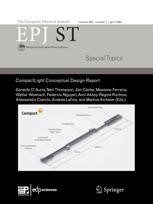An overview of neutrinos and their interactions
A new summary of the study of neutrinos, and the ways in which they interact with regular matter, could inspire both new and senior neutrino researchers to open up new areas of investigation within the field.
New York | Heidelberg, 18 February 2022
 The history of our understanding of neutrinos, from their astrophysical origins to their elusive interactions with matter, is full of surprises. Although we know that they are the second most abundant particles in the universe after photons, they are also the least well understood. In this special issue of EPJ ST, M. Sajjad Athar and S.K. Singh at Aligarh Muslim University present a short overview of the study of neutrinos, and the ways in which they interact with other forms of matter at mid-to-high energies.
The history of our understanding of neutrinos, from their astrophysical origins to their elusive interactions with matter, is full of surprises. Although we know that they are the second most abundant particles in the universe after photons, they are also the least well understood. In this special issue of EPJ ST, M. Sajjad Athar and S.K. Singh at Aligarh Muslim University present a short overview of the study of neutrinos, and the ways in which they interact with other forms of matter at mid-to-high energies.
Neutrinos are produced by a variety of astrophysical sources: including nuclear fusion in stellar cores, colossal supernova bursts, and decays of cosmic rays in Earth’s atmosphere. They can also be produced artificially by nuclear reactors and particle accelerators – allowing physicists to learn more about their intriguing properties. Yet since the particles carry no charge, and almost no mass, their interactions with other forms of matter are incredibly subtle – making them notoriously difficult to study.
The story of neutrino physics began in 1930, when Wolfgang Pauli proposed that a new family of particles would be needed to explain the conservation of certain values during nuclear reactions. Ever since, the story of neutrino research has continued to challenge our understanding of particle physics. Among the most intriguing mysteries is an effect named ‘neutrino oscillation’ – where the particles appear to spontaneously transition between three possible ‘flavours,’ as first observed by CERN’s Large Electron-Position Collider in 1989.
Explaining this behaviour will require the development of new physics beyond the Standard Model: which presents our best current descriptions of fundamental particles, and how they interact with each other. In the face of this challenge, Athar and Singh hope that this volume will benefit both students and young researchers, and senior researchers in neutrino physics, potentially helping to stimulate new ideas and areas of investigation.
All articles are available here and are freely accessible until 4 April 2022. For further information read the Editorial.
References: M.S. Athar and S.K. Singh on Neutrinos and their interactions. Eur. Phys. J. Spec. Top. 230, 4215–4220 (2021). https://doi.org/10.1140/epjs/s11734-021-00302-x
Further Information
For more information visit: www.epj.org
Services for Journalists
The full-text of the Editorial is available here.
Contact
Sabine Lehr | Springer | Physics Editorial Department
tel +49-6221-487-8336 | sabine.lehr@springer.com
